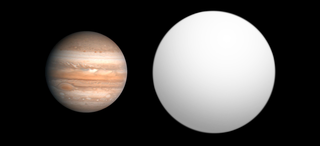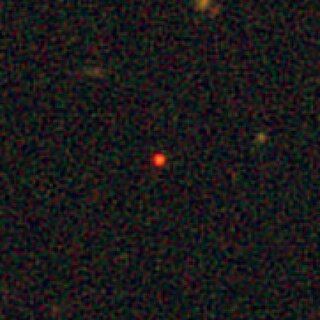Related Research Articles

A rogue planet, also termed a free-floating planet (FFP) or an isolated planetary-mass object (iPMO), is an interstellar object of planetary mass which is not gravitationally bound to any star or brown dwarf.

2M1207b is a planetary-mass object orbiting the brown dwarf 2M1207, in the constellation Centaurus, approximately 170 light-years from Earth. It is one of the first candidate exoplanets to be directly observed. It was discovered in April 2004 by the Very Large Telescope (VLT) at the Paranal Observatory in Chile by a team from the European Southern Observatory led by Gaël Chauvin. It is believed to be from 5 to 6 times the mass of Jupiter and may orbit 2M1207 at a distance roughly as far from the brown dwarf as Pluto is from the Sun.

A sub-brown dwarf or planetary-mass brown dwarf is an astronomical object that formed in the same manner as stars and brown dwarfs but that has a planetary mass, therefore by definition below the limiting mass for thermonuclear fusion of deuterium . Some researchers call them rogue planets whereas others call them planetary-mass brown dwarfs.

AB Doradus is a pre-main-sequence quadruple star system in the constellation Dorado. The primary is a flare star that shows periodic increases in activity.

1RXS J160929.1−210524 is a pre-main-sequence star approximately 450 light-years away in the constellation of Scorpius.
An object with the spectral type L can be either a low-mass star, a brown dwarf or a young free-floating planetary-mass object. If a young exoplanet or planetary-mass companion is detected via direct imaging, it can also have an L spectral type, such as Kappa Andromedae b.

CFBDSIR 2149-0403 is a free-floating planetary-mass object or possibly a high-metallicity, low-mass brown dwarf in the constellation Aquarius. Originally, it was thought to be part of the AB Doradus moving group (ABDMG) as indicated by its position and proper motion, but the same team that discovered the object and conjectured its membership in the group has now rejected that hypothesis due to newer measurements. Without that membership, the age and mass of the object cannot be constrained. There is insufficient evidence to demonstrate that CFBDSIR 2149-0403 formed as a planet and was subsequently ejected.

2MASS J03552337+1133437 is a nearby brown dwarf of spectral type L5γ, located in constellation Taurus at approximately 29.8 light-years from Earth.

GU Piscium b (GU Psc b) is a directly imaged planetary-mass companion orbiting the star GU Piscium, with an extremely large orbit of 2,000 AU (3.0×1011 km), and an apparent angular separation of 42 arc seconds. The planet is located at right ascension 01h 12m 36.48s declination +17° 04′ 31.8″ at a distance of 48 pc (160 ly).

GU Piscium is a star in the constellation Pisces. An RS Canum Venaticorum variable, it ranges from magnitude 12.96 to 13.24 over 1.04 days. It is 48 Parsecs distant from Earth. This star is also believed to be a member of the AB Doradus moving group with a membership probability of 96.9%.
HD 23514, is a star in the Pleiades. It is a main-sequence star of class F6, and has been seen to have hot dust particles orbiting around it. These materials, otherwise known as planetesimals which orbit within a circumstellar disc, are evidence of possible planetary formation. The debris disk shows evidence of being rich in silica.

51 Eridani is a star in the constellation Eridanus. It has an apparent magnitude of 5.22, meaning it is just visible to the unaided eye in suburban and rural skies. The primary star's absolute magnitude is 2.87. There is also a binary star named GJ 3305 which shares the same proper motion through space with it, making it overall a triple star system.
A Peter Pan disk is a circumstellar disk around a star or brown dwarf that appears to have retained enough gas to form a gas giant planet for much longer than the typically assumed gas dispersal timescale of approximately 5 million years. Several examples of such disks have been observed to orbit stars with spectral types of M or later. The presence of gas around these disks has generally been inferred from the total amount of radiation emitted from the disk at infrared wavelengths, and/or spectroscopic signatures of hydrogen accreting onto the star. To fit one specific definition of a Peter Pan disk, the source needs to have an infrared "color" of , an age of >20 Myr and spectroscopic evidence of accretion.

The Tucana-Horologium association (Tuc-Hor), or Tucana Horologium moving group, is a stellar association with an age of 45 ± 4 Myr and it is one of the largest stellar associations within 100 parsecs. The association has a similar size to the Beta Pictoris moving group (BPMG) and contains, like BPMG, more than 12 stars with spectral type B, A and F. The association is named after two southern constellations, the constellation Tucana and the constellation Horologium.
HAT-P-15 is a G-type main-sequence star about 630 light-years away. The star is older than Sun yet has a concentration of heavy elements roughly 190% of solar abundance. The star has no noticeable starspot activity.
HD 217786 is a binary star system in the equatorial constellation of Pisces. With an apparent visual magnitude of 7.78, it requires binoculars or a small telescope to view. The system is located at a distance of 181 light-years from the Sun based on parallax, and is drifting further away with a radial velocity of +10 km/s. Kinematically, the star system belongs to the thin disk population of the Milky Way.
2MASS J01225093−2439505 is a M-type main-sequence star. Its surface temperature is 3530±50 K. 2MASS J01225093−2439505 is much younger than the Sun at an age of 0.12 billion years. Kinematically, the star belongs to the AB Doradus moving group.
References
- 1 2 Zuckerman, B.; Song, I. (2004). "The AB Doradus Moving Group". The Astrophysical Journal . 613 (1): L65–L68. Bibcode:2004ApJ...613L..65Z. doi: 10.1086/425036 .
- ↑ Hormuth, F.; Brandner, W.; Hippler, S.; Janson, M.; Henning, T. (2007). "Direct imaging of the young spectroscopic binary HD 160934". Astronomy and Astrophysics . 463 (2): 707–711. arXiv: astro-ph/0612158 . Bibcode:2007A&A...463..707H. doi:10.1051/0004-6361:20066765. S2CID 14788968.
- 1 2 Barrado y Navascues, D.; Stauffer, J.R; Jayawardhana, R. (2004). "Spectroscopy of Very Low Mass Stars and Brown Dwarfs in IC 2391: Lithium Depletion and Hα Emission". Astrophysical Journal . 614 (1): 386–397. arXiv: astro-ph/0406436 . Bibcode:2004ApJ...614..386B. doi:10.1086/423485. S2CID 208867491.
- ↑ Luhman, K.L.; Stauffer, J.R; Mamajek, E.E. (2005). "The Age of AB Doradus". Astrophysical Journal . 628 (1): L69–L72. arXiv: astro-ph/0510665 . Bibcode:2005ApJ...628L..69L. doi:10.1086/432617. S2CID 10101115.
- ↑ Ortega, V. G.; Jilinski, E.; de la Reza, R.; Bazzanella, B. (2007). "On the common origin of the AB Doradus moving group and the Pleiades cluster". Monthly Notices of the Royal Astronomical Society . 377 (1): 441–445. arXiv: astro-ph/0702315 . Bibcode:2007MNRAS.377..441O. doi: 10.1111/j.1365-2966.2007.11614.x . S2CID 8344404.
- ↑ Barenfeld, S.A.; Bubar, E.J.; Mamajek, E.E.; Young, P.A. (2013). "A Kine-chemical Investigation of the AB Dor Moving Group "Stream"". Astrophysical Journal . 766 (1): 6. arXiv: 1301.5036 . Bibcode:2013ApJ...766....6B. doi:10.1088/0004-637X/766/1/6. S2CID 119280220.
- ↑ Bowler, B.P.; Liu, M.C.; Shkolnik, E.L.; Dupuy, T.J.; Ciezas, L.A.; Kraus, A.L.; Tamura, M. (2012). "Planets around Low-mass Stars (PALMS). I. A Substellar Companion to the Young M Dwarf 1RXS J235133.3+312720". Astrophysical Journal . 753 (2): 142. arXiv: 1205.2084 . Bibcode:2012ApJ...753..142B. doi:10.1088/0004-637X/753/2/142. S2CID 119228703.
- ↑ Wahhaj, Zahed; Liu, Michael C.; Biller, Beth A.; Clarke, Fraser; Nielsen, Eric L.; Close, Laird M.; Hayward, Thomas L.; Mamajek, Eric E.; Cushing, Michael; Dupuy, Trent; Tecza, Matthias; Thatte, Niranjan; Chun, Mark; Ftaclas, Christ; Hartung, Markus; Reid, I. Neill; Shkolnik, Evgenya L.; Alencar, Silvia H. P.; Artymowicz, Pawel; Boss, Alan; De Gouveia Dal Pino, Elisabethe; Gregorio-Hetem, Jane; Ida, Shigeru; Kuchner, Marc; Lin, Douglas N. C.; Toomey, Douglas W. (2011). "The Gemini Nici Planet-Finding Campaign: Discovery of a Substellar L Dwarf Companion to the Nearby Young M Dwarf Cd–35 2722". The Astrophysical Journal. 729 (2): 139. arXiv: 1101.2893 . Bibcode:2011ApJ...729..139W. doi:10.1088/0004-637X/729/2/139. S2CID 118313067.
- ↑ "Lost in Space: Rogue Planet Spotted?". ESO. 14 November 2012. Retrieved 14 November 2012.
- ↑ Delorme, P.; et al. (2012). "CFBDSIR2149-0403: a 4-7 Jupiter-mass free-floating planet in the young moving group AB Doradus ?". Astronomy & Astrophysics. 548: A26. arXiv: 1210.0305 . Bibcode:2012A&A...548A..26D. doi:10.1051/0004-6361/201219984. S2CID 50935950.
- ↑ Bowler, Brendan P.; Liu, Michael C.; Shkolnik, Evgenya L.; Dupuy, Trent J. (2013). "Planets Around Low-Mass Stars. III. A Young Dusty L Dwarf Companion at the Deuterium-Burning Limit". The Astrophysical Journal. 774 (1): 55. arXiv: 1307.2237 . Bibcode:2013ApJ...774...55B. doi:10.1088/0004-637X/774/1/55. S2CID 119107288.
- ↑ Bowler, Brendan P.; Liu, Michael C.; Mawet, Dimitri; Ngo, Henry; Malo, Lison; Mace, Gregory N.; McLane, Jacob N.; Lu, Jessica R.; Tristan, Isaiah I.; Hinkley, Sasha; Hillenbrand, Lynne A.; Shkolnik, Evgenya L.; Benneke, Björn; Best, William M. J. (2016). "Planets Around Low-Mass Stars (Palms). Vi. Discovery of a Remarkably Red Planetary-Mass Companion to the Ab Dor Moving Group Candidate 2Mass J22362452+4751425". The Astronomical Journal. 153: 18. arXiv: 1611.00364 . doi: 10.3847/1538-3881/153/1/18 . S2CID 3165698.